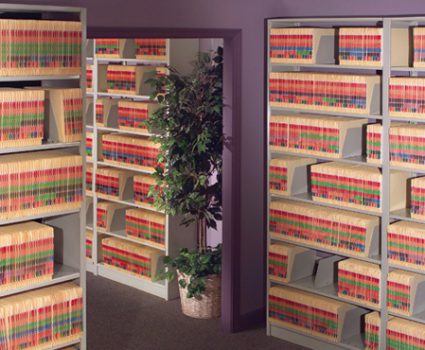
Color-coding (Part 2): A simple way to avoid costly problems
 In the first blog of a four-part series, we discussed the color-coded file folder. Now, we turn our attention to the technique of color-coding, a simple and highly effective records management tool.
In the first blog of a four-part series, we discussed the color-coded file folder. Now, we turn our attention to the technique of color-coding, a simple and highly effective records management tool.
In this post, we’ll look beyond the obvious and immediate benefits of color-coding. As you’ll see, it can help avoid some potentially serious consequences, such as operational downtime, lost business opportunities, and legal sanctions.
Color-coding tends to be surrounded by a number of misconceptions. One is that color-coding is merely a “convenience” that makes the lives of file room workers a little easier. The other common misconception is that color-coding is really just for high-touch, active filing situations such as those in doctors offices and law firms.
The reality is that color-coding plays a much more significant role – and has many more applications – than most people give it credit for.
|
A simple fix that prevents costly consequences
Color-coding makes it easier to locate and retrieve files, and it also provides a simple and reliable way to spot misfiled documents. At the ground level, the benefits in the file room are pretty clear, it improves productivity and saves the time and hassle of tracking down missing files. Looking beyond these immediate benefits, something much more significant is going on. The simple practice of color-coding actually helps you avoid some very serious business consequences, including:
- Operational down time: in industries that require regular use of paper files in order to function – such as engineering, architecture, energy and finance – each file retrieval is a critical part of the production path. When they take on aggregate, long retrieval times and searches for missing files, it can add up to big dollars in lost productivity.
- Lost business opportunities: Recent years have seen a marked increase in acquisition and divestiture activity. Success in many different sectors depends on a company’s ability to acquire the right assets at the right time. When an asset goes up for sale, the bidding process can be fast and intense. The practice of color-coding lets you retrieve important records when needed, allowing you to make faster decisions and avoid missing out on strategic business deals.
- Legal sanctions: When auditors come calling for information about your environmental record, employee safety practices or your tax account, you won’t get all the time in the world to produce the requested documentation. Again, the use of color-coding here can be immensely helpful, allowing you produce the required documentation in a timely fashion and avoid hefty fines, damages or even possible jail time.
As we can see, the real benefits of color-coding go far beyond convenience for file room staff. When we consider those benefits and think about the potential consequences, it naturally leads us to ask: are we using color-coding everywhere that we should be?
Many businesses are already extending the practice to a larger portion of their collections – even those that are not heavily used. Why? As we say at TAB, it is better to spend pennies on good records management practices than to lose millions on negative business outcomes. Stay tuned for part 3 on meeting legal requirements for records retention and disposition.





